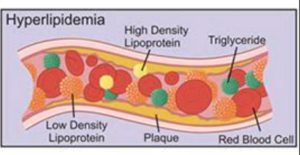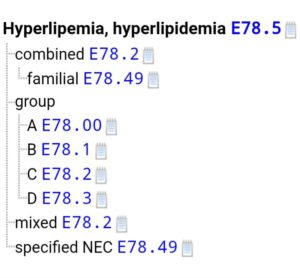Hyperlipidemia ICD 10
In this topic let us learn about Hyperlipidemia, different types of lipids, Hyperlipidemia ICD 10 Codes description and Hyperlipidemia ICD 10 guidelines along with examples.
Hyperlipidemia:
Hyperlipidemia refers to increase in any type of lipid (fat) in blood. We use common name “high cholesterol” instead of saying hyperlipidemia.
Though not in detail, it is important to understand the basics of lipids to code to the highest specificity.
There are two types of lipids:
- Triglycerides
- Cholesterol
Triglycerides:
Have you ever thought what our body does with extra calories it gets from food.These are converted to triglycerides and stored in fat cells. When needed, mostly in between meals, it is utilized as energy. So, it is very clear when the amount of extra calorie increases in turn the level of triglycerides also increases.
Cholesterol:
Body cells require cholesterol for its growth. A part of this is made by liver and another part comes from foods we eat. Altogether when body gets extra cholesterol, it gets stored in blood vessels.
LDL cholesterol –These are called “bad cholesterol” because it gets stored in blood vessels.
HDL cholesterol – These are called “good cholesterol” because it transports part of LDL from blood to liver and it will be expelled from the body.
Both triglycerides and cholesterol stick to the wall of blood vessels and form plaques. Gradually blood vessel becomes narrow and makes it difficult to pass the blood and cause block. Sometimes clots are formed and travel to either heart or brain and it cause heart attack or stroke. Hence increase in the level of lipids is risk factors for cardiovascular problems and stroke. It may even cause obesity, fat deposits on skin, enlargement of organs like spleen, pancreas or liver.


Lipid Panel – It is a lab test using specimen as blood to find any type of fat increase in blood. As hyperlipedemia does not cause any symptoms it is necessary to do lipid Panel to know the status.
Hyperlipidemia ICD 10 Codes guidelines:
It is located in ICD-10 CM manual chapter 4, Endocrine, nutritional and metabolic diseases (E00-E89)
Hyperlipidemia can occur due to food habit, secondary to any other underlying disease, genetic abnormalities or idiopathic (unknown cause). If it is secondary to any other disease, both primary and secondary should be coded, remember to apply combination coding guidelines if applicable.
Highest specificity code should be assigned in case of hyperlipidemia. For example, if both hypercholesterolemia and mixed hyperlipidemia are documented in assessment then only one code should be coded, that is mixed hyperlipidemia.

| Hyperlipidemia ICD 10 Code | Description |
|---|---|
| E78.0 | Pure hypercholesterolemia group A |
| · E78.00 | Pure hypercholesterolemia Fredrickson's hyperlipoproteinemia, type Iia Hyperbetalipoproteinemia (Pure) hypercholesterolemia NOS |
| · E78.01 | Familial hypercholesterolemia |
| E78.1 | Hyperlipidemia, group B Pure hyperglyceredemia Endogenous hyperglyceredemia Fredrickson's hyperlipoproteinemia, type IV Hyperprebetalipoproteinemia |
| E78.2 | Hyperlipidemia, group C Mixed/combinedhyperlipidemia Elevated cholesterol with elevated triglyceridrs |
| E78.3 | Hyperlipidemia, group D Hyperchylomicronemia Mixed hyperglyceridemia Fredrickson's hyperlipoproteinemia, type I or V |
| E78.4 | Other hyperlipidemia |
| · E78.41 | Elevated lipoprotein |
| · E78.49 | Other hyperlipidemia Familial combined hyperlipidemia |
| E78.5 | Hyperlipidemia, unspecified |
| E78.6 | Lipoprotein deficiency Abetalipoproteinemia Depressed HDL cholesterol High-density lipoprotein deficiency Hypobetalipoproteinemia (familial) |
| E78.7 | Bile and cholesterol metabolism disorders |
| · E78.70 | Bile and cholesterol metabolism disorder, unspecified |
| · E78.71 | Barth syndrome |
| · E78.72 | Smith-Lemli-Opitz syndrome |
| · E78.79 | Bile and cholesterol metabolism disorder, other specified |
| E78.8 | Other disorders of lipoprotein metabolism |
| · E78.81 | Lipoid dermatoarthritis |
| · E78.89 | Other lipoprotein metabolism disorder |
| E78.9 | Disorder of lipoprotein metabolism, unspecified |
Hyperlipidemia ICD 10 Example 1:
58 year old male with known history of DM2, hypertension and CAD presents for an initial visit. He quit smoking 2 years ago. Medication list includes Lisinopril, insulin, clopidogrel.
Physical exam documented as morbid obese with BMI 40.2 kg/m², BP 142/90 mm Hg
Labs/procedures: FBG 140 mg/dL, A1C 7.0 %
Lipid profile: total cholesterol (TC) 255 mg/dL, HDL-C 42 mg/dL, triglycerides 350 mg/dL, LDL-C 143mg/dL
Physician diagnosed as “DM with mixed hyperlipidemia”
Prescribed atorvastatin 20 mg daily and counselled on diet to reduce weight.
Codes – E11.69, E78.2, I10, E66.2, I25.10, Z79.4, Z68.41, Z71.3
Here we need to use combination code of DM and hyperlipidemia E11.69 also as Physician has linked both.
Hyperlipidemia ICD 10 Example 2:
65‐year‐old woman (NKDA) comes to clinic for annual wellness exam. She has no prior history of Cardiac disorders, no DM.She has hypothyroidism and hyperlipidemia.She has a family history of MI (father died of MI at age 45). She is a non-smoker, drinks 1 glass wine daily. Current medication list includes thyroxine 0.05 mg per daily, pravastatin 10 mg, fish oil
Physical exam including vitals documented as normal except BMI 36.2 kg/m².All the screening examinations performed today including depression screen, breast cancer screening. Lipid profile showed Total cholesterol 260 mg/dl, Triglycerides 175 mg/dl, HDL‐C 42 mg/dl, LDL‐C 193 mg/dl
Final impression: AWV, hypothyroidism, hypercholesterolemia
Codes – Z00.00, E78.00, E03.9, Z68.36